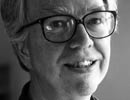
|
malcolm wright portfolio catalogues news & events the kiln contact us |
| Malcolm and his wife, Marjorie, established The Turnpike Road Pottery upon their return from Japan in 1970. While Marj is not a potter, she has assisted in the studio from the beginning, although she took 17 years off to work as a travel agent. The Wrights have two grown sons, Ian and Shaun. Ian, his wife, Cindy and their daughter, live in Dallas, where he works in the banking industry. Shaun, who lives with his wife Marina in Ubatuba, Brazil, a 10 minute walk from the beach, does black and white landscape photography. See his work at www.shaunwrightphotography.com. Marina Stock Wright’s jewelry can be seen at www.mwrightjewelry.com. ARTIST’S STATEMENT In my college years I was interested in the roots of modernism, from the development of cubism, constructivism and futurism to Scandinavian design, and the time/space elements in architecture. These interests were interrupted for 30 years by my deep involvement with Japan, functional pottery for food and flowers and in the ascetic, restrained taste of tea ceremony pottery. Over the last 20 years my early interest has reawakened. Walking around the fields among Chuck Ginnivers’s monumental sculptures, here in Vermont, inspired me to revisit these interests. Slowly, I became aware of the power of minimalism as expressed in Tony Smith’s work. More recently, the work of Jorge Oteiza and the foam sculptures of John Chamberlin have been a source of inspiration. The nature of clay, and my years working with tabletop scale, directs me to a small size that is comfortable, yet retains power. I am interested in dry surfaces, without ash build up, and negative space. I think the sense of Japanese restraint and Western minimalism combine, in these pieces, the forms and ideas I studied more that 40 years ago. PORTFOLIO Please note that the pieces that appear on this site are unique works, representing a cross section of the type of work Malcolm has created over the years. He does not work as a production potter with a regular "line" but there is usually a good selection of pieces in the studio. (note: the studio is closed as of 2017, work may be found on the secondary market.) If you see a shape or glaze that interests you, please identify it and we can send you a photograph of similar pieces that are currently available, along with the price. Prices do vary depending upon the quality of the finished piece. See PRICE GUIDE in the portfolio section. PHILOSOPHY I am interested in the functional pot, but not to exclusion. The notions of Japanese functional pottery form the basis for my work: how does the pot feel in my hand? How does food look in the pot? Does the lip invite you to drink from the pot or warn you to keep your distance? Is the pot as enjoyable during the unseemly process of being washed as it was sitting in state on the shelf? Pottery has to do with communication. When the potter wants to make a particular form, the clay may not want (or be able) to stretch to the desired shape without falling down. So the potter must adjust to accommodate the clay, or change clay. Glazed pottery collects light. The color of the glaze depends upon its chemistry and on the color of the clay underneath. Light is reflected from the surface, angles and edges of the form, affecting how we react to a pot. Do we reach to touch it, admire it from a distance, or look away? In the hand of the user, the pot controls us and communicates with us. The potter's wheel dictates circular forms, and accordingly, I have made many bowls and vases. However, an interest in geometry, Constructivism and Futurism has led me over the years to make abstract forms for flower arranging, assembled from extruded parts or tubes. Some extruded forms are carefully conceived, planned and executed. But when a piece is finished some scraps are left over. From this point I proceed intuitively to discover what these parts will become. When a form is strong in and of itself and doesn't need flowers for completion, I will finish and fire the piece without a hole, and present it as sculpture. I use stoneware, porcelain and brick clay, and also combine them to give me a broad palette of color and surface. I work with the wheel and the extruder, producing both the round vase and the less familiar angular vase. No matter how the forms are created, I think of both in geometric terms and also in terms of use. The surfaces of unglazed porcelain and brick clay are different colors, but of similar feeling: the glazed works represent a more familiar sensibility. It is the wood firing that unites all of the directions. I am interested in the source of an idea, and how one idea can be developed in two directions at once, both in a soft rounded form and in an angular geometric form, both carrying the same thrust of the original thought. When I look at the small porcelain bowl and the large brick clay extruded sculpture, they are extreme opposites, but they are clearly my work. |
| home | contact us | malcolm wright | portfolio | news & events | kiln | catalogues | glaze formulas |
copyright © 2025 turnpike road pottery site design: eismontdesign